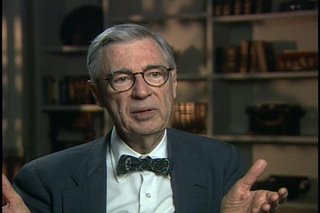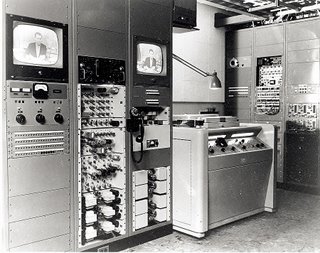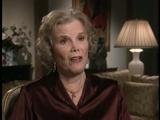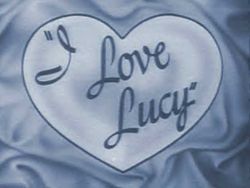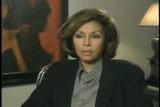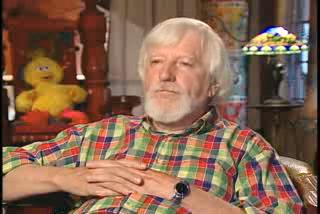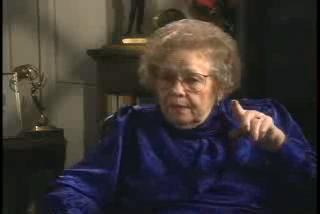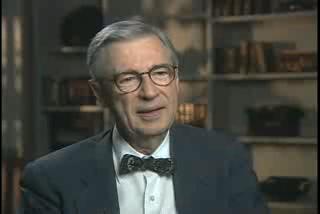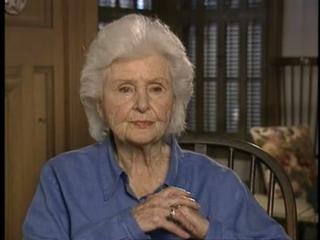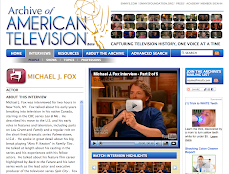Dr. Frank Stanton, who served as President of CBS from 1946 to 1973, died Sunday, December 24th at the age of 98. He granted the Archive of American Television a rare 2-part videotaped interview in 2000 and 2001. Below are some excerpts from the three hour interview. The entire interview can be accessed by clicking here:

On joining CBS in 1935.
I got my doctorate in late August, 1935. We got in the car the next day and drove to New York and I think my first day at CBS was the 4th of September. I was just staff, nobody labeled me anything. I was a weird sort of a person because I was introduced to the sales force as somebody that might help them in market research. They were very skeptical of somebody who had a Ph.D. In those days, Ph.D.’s on Madison Avenue were not a dime a dozen. Today I think they are. In those days I think there were only two of us, George Gallop at Young and Rubicam, at 285 Madison and Frank Stanton at 485 Madison. CBS was very young. It was on a two or three floors in the building.
On bringing Ed Sullivan to CBS television.
You reached for stars wherever you thought there was a potential. For example, I went up to the Essex House hotel and sold Ed Sullivan to an advertiser for I think six weeks one summer with the idea that Ed Sullivan, certainly not telegenic -- Sullivan wasn’t very happy to even get in front of a camera. But Sullivan had, with his column in the Daily News, an enormous amount of contacts. And Sullivan could get those people on to interview them. That’s what we started out with, with Ed Sullivan on Sunday night. We had to frame it with some dancers in order to give it some entertainment flair, but Sullivan was that star on Sunday night. People said “well you’re not gonna keep that guy on Sunday night.” By the time his eight weeks were over, he had an audience and we said, let’s give him another 13 weeks. He ended up owning the first part of Sunday night for many years. That’s how Ed Sullivan came into television.
On his relationship with CBS Chairman William Paley.
We both had the same objective. We wanted CBS to be the best and we had perhaps different routes to getting there. So we started with that common goal. I devoted most of mine in terms of programming. I guess I gave most of my attention and support to the news side. He gave most of his attention to the entertainment side. Although a couple of the big things we had in entertainment, were things I brought in for example, Arthur Godfrey was my project. Playhouse 90 was mine. I had a strong hand in bringing Lucy to CBS.
On Ed Murrow’s taking on Joseph McCarthy on See It Now.
Fred Friendly and the producing crew and Ed Murrow, felt that the time was come to take the McCarthy record and put it all together and into a half-hour and what was it in See It Now. They developed it without talking about it much in the company, in fact, very little. I don’t think the head of news at that time, who was Sig Mickelson, knew that the program was in preparation. About 24 hours before it was broadcast, I got a call from Ed who said he had tried to reach Paley and could the two of us meet with, with Ed and Fred Friendly, late that afternoon. I said I couldn’t be sure we could get together. Maybe we could do it tomorrow. And Ed said no, it should be today. It turned out that about four o’clock that day, Ed and Fred came up and laid before us the idea of the McCarthy expose and offered to show us advance material from the broadcast. It was all on film in those days. Either Paley or I or both of us declined looking at it and said, it had to be fair and it had to provide for time for reply, if that was indicated on the basis of the content, which we damn well knew was going to happen. So that was built into the broadcast I believe at the opening or close or maybe both, Murrow indicated that time would be given to the Senator to respond to the broadcast. The broadcast obviously was a bombshell, it wasn’t that we didn’t expose anything that hadn’t been known because Look Magazine had done a very rough piece on McCarthy and others had done individual stories. But Murrow, with Friendly’s help, put together a See It Now broadcast that shook the whole journalism field. And it befelled to me to handle the Senator in terms of the reply. But we lived through it and it was a great coup for Murrow and Friendly.
On the Blacklist at CBS.
There was a supermarket man someplace upstate New York who began saying that he wouldn’t handle merchandise that was advertised by Communists and was specific about naming names. Some advertisers became very nervous. The chairman of General Food scalled me one day and said he really wanted to sit down and talk with me about this. We had The Goldbergs and a couple of other programs on for General Foods. He said that if certain people had were continued on that program, he would withdraw General Foods advertising from CBS. And a number of other advertisers took similar views. The FBI was making private comments to us about some of the people. We didn’t know what the facts were. We had no way of knowing what the facts were. NBC was in the same boat but we had more popular programs and somehow we had more people who were on the so-called Blacklist. At about that time, it got so complicated and so difficult, that we asked the employees to sign a loyalty oath. I don’t recall anybody refusing to sign the loyalty oath. People in News signed it. Ed Murrow signed it. Ed Murrow, I think at that time, was on the CBS Board and he supported it. None of us was happy.
On championing the repeal of Section 315 of the Communications Act.
Section 315 of the Communications Act, said that if one candidate got on the air, all of the candidates had to have access equal access to radio. This is long before television. As a result, if you put a Republican on, you had to put all the other Republicans on who were running for the same office if they wanted the time and it just destroyed the opportunity to use the medium effectively as a news medium. It became clear to me that the only way to resolve that was to get rid of Section 315. I think in the early ‘50’s I wrote a column in the then Herald-Tribune proposing debates between the presidential, presidential candidates and the relief from Section 315. And that became sort of a crusade as far as I was concerned. I was joined in by other broadcasters, eventually NBC came along and we got rid of Section 315 on a temporary basis in the election of 1960. It took that much time to get the right to put both candidates on at single broadcasts. We did the first televised debate, which was also done on radio, in 1960 and it originated in our studios in Chicago, with Kennedy and Nixon. That debate put them on so that the Republicans could see the Democrats and vice versa. It was an opening up of the air to political broadcasts. I thought, mistakenly, as it turns out, that doing those debates would bring more people out to the polls, certainly in the presidential year of 1960, I believe it did that.
On The Selling of the Pentagon.
I arrived at my house about 9:30, having missed dinner. And I’d worked at the office and I came in and my wife said, “don’t do anything. You get in and look at what’s on the air cause I think you’re gonna have trouble with it.” And I knew what was on but I hadn’t seen it. I had been told in general what it was. So I went in and watched the end of the program. And before the end came, I began getting calls about how dare we put that broadcast on. The next morning, Ted Koop who was in our Washington office as the Vice President called me and said, the Pentagon wants to see all the footage on The Selling of the Pentagon. I said send it over to them. So we had a tape in the Washington Bureau and we sent it over to the Pentagon and word came back immediately. “No we don’t want the broadcast, we want the tape that wasn’t used.” And the questioning came to me, what’ll we do and I said tell them to forget about it. We’re not releasing tape that we didn’t put on the air, those are the reporter’s notes. … I took the traditional position that these were the property of the news organization and I would not submit them to the government. And that began a whole series of things including the day when two armed uniformed guards appeared at CBS and wanted to see me to deliver a subpoena to provide this material. It was a little ludicrous because it was a serious move on the part of the government but it was silly because they could have delivered that subpoena to me in Washington where I had officers who could have accepted it on behalf of CBS. At any rate, we stood our ground and there were hearings. The committees, there were two subcommittees I believe, or maybe three, had hearings. I lost among each of the three, the vote was in favor of forcing me to give up the documents. It finally came to a vote of a full committee and we lost the vote with the full committee. I was cited for contempt of Congress and John Mitchell told me the morning after the vote that he was all prepared to send me to jail. It ultimately ended up on the floor of the full House and we didn’t squeak by but we didn’t have the majority I would like to have had. But we prevailed.
On the industry’s embracing the V-chip.
I’m embarrassed for the industry, of the leaders, for having done that but I think that’s just the beginning of things that’ll be worse. I think with the ownership now of the broadcast facilities and cable in the hands of big corporation, there will not be dedication to the First Amendment that we had when we were independently in quotes, owned ala NBC, a part of RCA and CBS being owned as it was. I don’t see that kind of leadership putting aside the impact it would have had on the stock prices in favor of a principle like the First Amendment. Newspapers are still standing their ground on the First Amendment. I don’t know what’s going to happen in broadcasting.
On his life’s satisfactions.
Public service. Architecture. Travel. The last eight years have been rather desolate years for me because I lost my wife eight years ago and that companionship had been with me from the time I was 12 years old, so it was like losing my arms, and legs and heart. I haven’t had any trouble keeping myself occupied. I think I’ve been on interesting boards. I’ve been identified with some interesting projects. I have no complaints. I was a lucky guy.
Interview description:
In this rare videotaped interview, executive Dr. Frank Stanton discusseshis early years at CBS and his eventual rise to the network’s presidency. He speakscandidly about CBS, chairman William S. Paley and the rise of CBS network television. Dr. Stanton retired from his post in 1973, but continued as a director of the company. He was interviewed by Don West on May 22, 2000 and May 14, 2001.
Link to The New York Times obituary of Frank Stanton.





